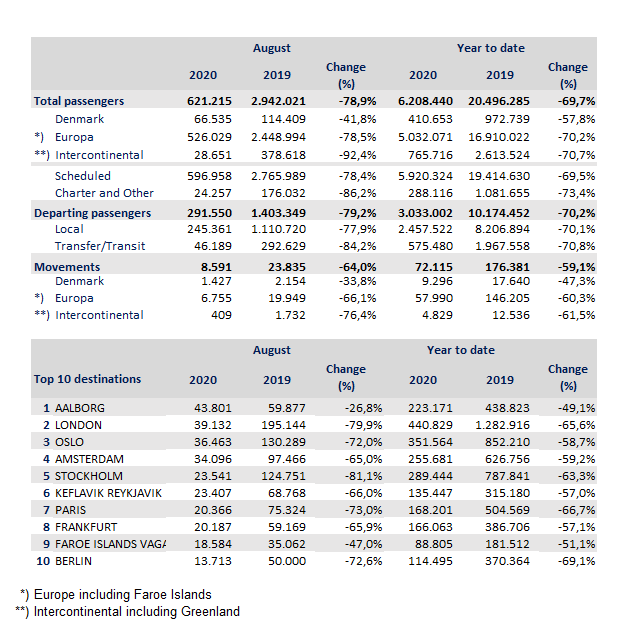CPH traffic data: Passengers stayed away this summer
Lower fares and more routes in and out of Copenhagen Airport, but uncertainty about travel restrictions in Europe prevented passenger numbers from following suit. Only every other seat filled, and reopening became stagnant in August. This could have serious consequences for Denmark. A total of 1,3 million passengers passed through the airport in the period June-August, which was 85 per cent fewer than the almost 9 million passengers recorded for the summer months of 2019. The charter segment was particularly hard hit.
“It's very worrying to see that instead of the budding recovery in traffic seen in early summer stagnation has now set in. The aviation industry is hit by the worst crisis since World War II, and the risk is that it will cause lasting damage to Denmark’s connectivity to the world. Competition for air routes is intense and it’s set to become even tougher. It’s very important that Denmark doesn’t fall behind in this context,” says Chief Commercial Officer Peter Krogsgaard of Copenhagen Airports A/S.
“Everybody is waiting for an effective treatment and an accessible COVID-19 vaccine, so the world can reopen, the restrictions can be lifted and we can again travel freely. Until that happens, we must do everything we can to make travelling as safe and secure as possible,” he says.
Passengers staying away
Face masks, social distancing and extra passport checks at border control has become an everyday reality at Copenhagen Airport. The Tax Free shop and a number of other retail units and eateries have reopened, and slowly more and more will be joining them, but the passengers are staying away.
“Air fares have even fallen instead of going up as was widely predicted when the coronavirus crisis struck. People can feel safe and secure at the airport. We now have flights to 100 destinations, but uncertainty about travel restrictions and quarantine rules that can be difficult to understand have put a damper on our enthusiasm for travelling. The result is that people are not travelling in any great numbers – neither for leisure nor for business. Only about half the seats available are being sold. In other words, this is an extremely serious situation for the airlines and for the airport,” says Krogsgaard.
Quietest summer in living memory
Under the shadow of the coronavirus, this summer was the quietest in living memory with a mere 1,3 million passengers, a decline of 85 per cent relative to the summer of 2019 when 9 million passengers passed through the terminals during June, July and August.
The summer season seemed somewhat promising at first. There were 15,000 travellers during the first week of June, and they all travelled by scheduled flights to and from a mere 18 destinations. The numbers grew steadily in July but since became stagnant in August while the number of scheduled flight destinations has since risen to 100.
The latest traffic data for August show a 79 per cent drop in passenger numbers relative to last year: from 2,942,021 to 621,215 this year.
CPH estimates that traffic for the full year will be at 30 to 35 per cent of the 2019 figures. According to international aviation organisations, it may be 2022 or 2024 before traffic recovers to previous levels – depending on when a vaccine is ready.
Charter traffic particularly affected
Charter flights are the hardest hit this summer. Last summer, Copenhagen Airport had charter flights to 72 destinations. This year, the figure was 30, and there were considerably fewer flights to the few destinations available. The number of charter flight seats for sale fell by 92 per cent, from 568,000 last year to just 51,000 this summer. On scheduled flights, the number of seats for sale dropped by 77 per cent.
“The many travel restrictions in Europe have had a particularly strong impact on charter flights. The number of charter passengers this summer fell by 94 per cent compared to 2019, from 534,000 to fewer than 32,000,” explains Krogsgaard.
